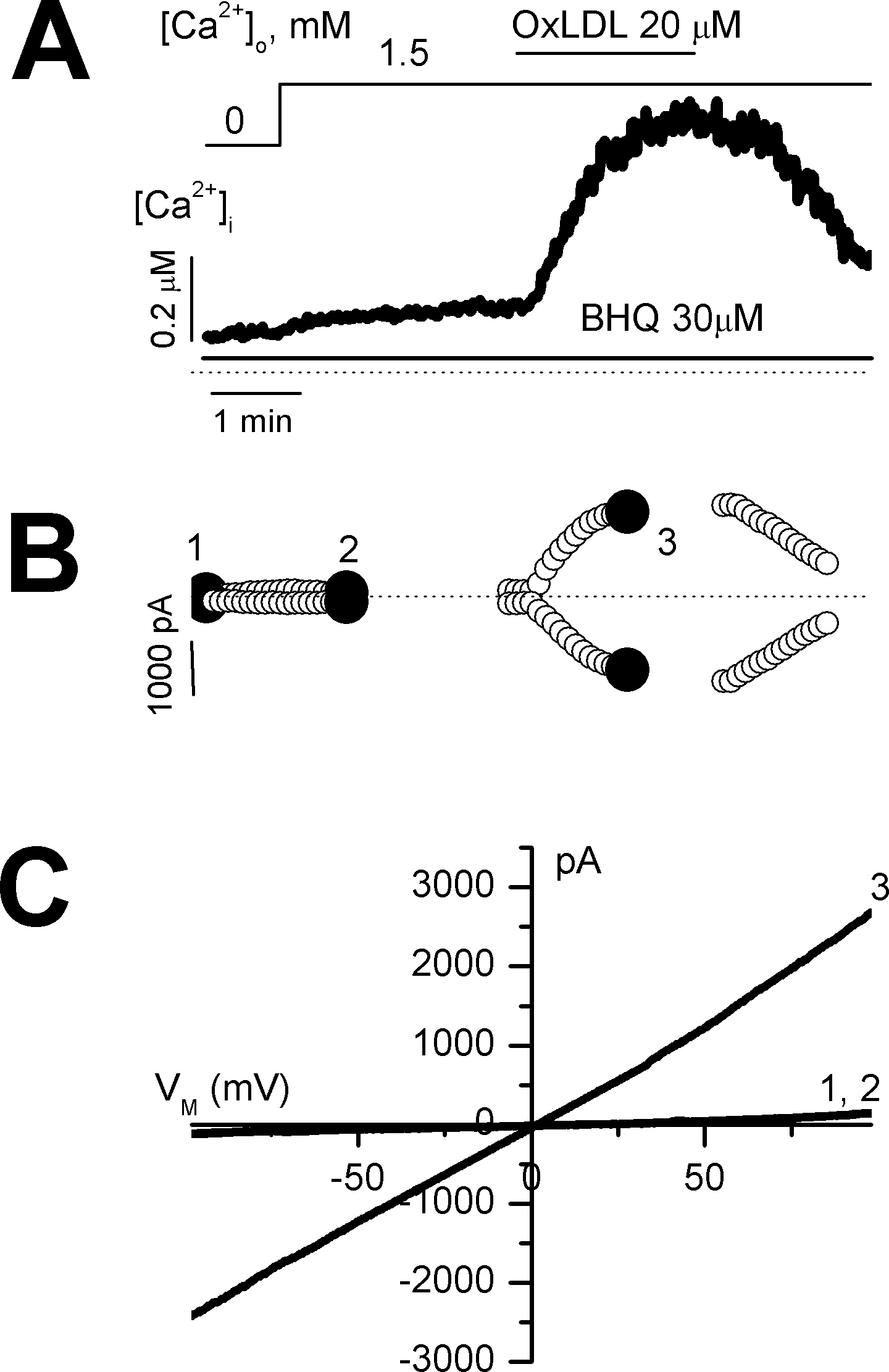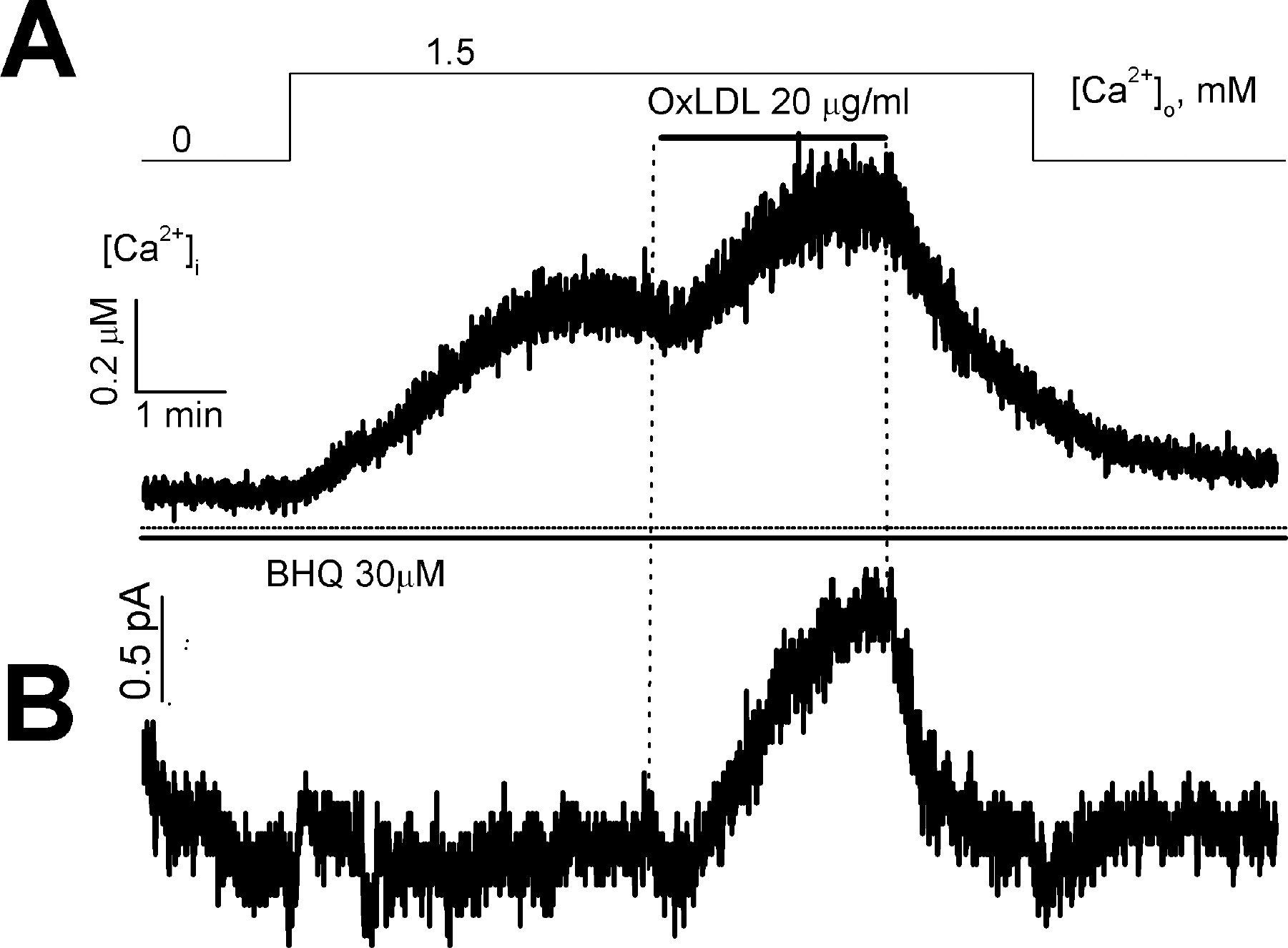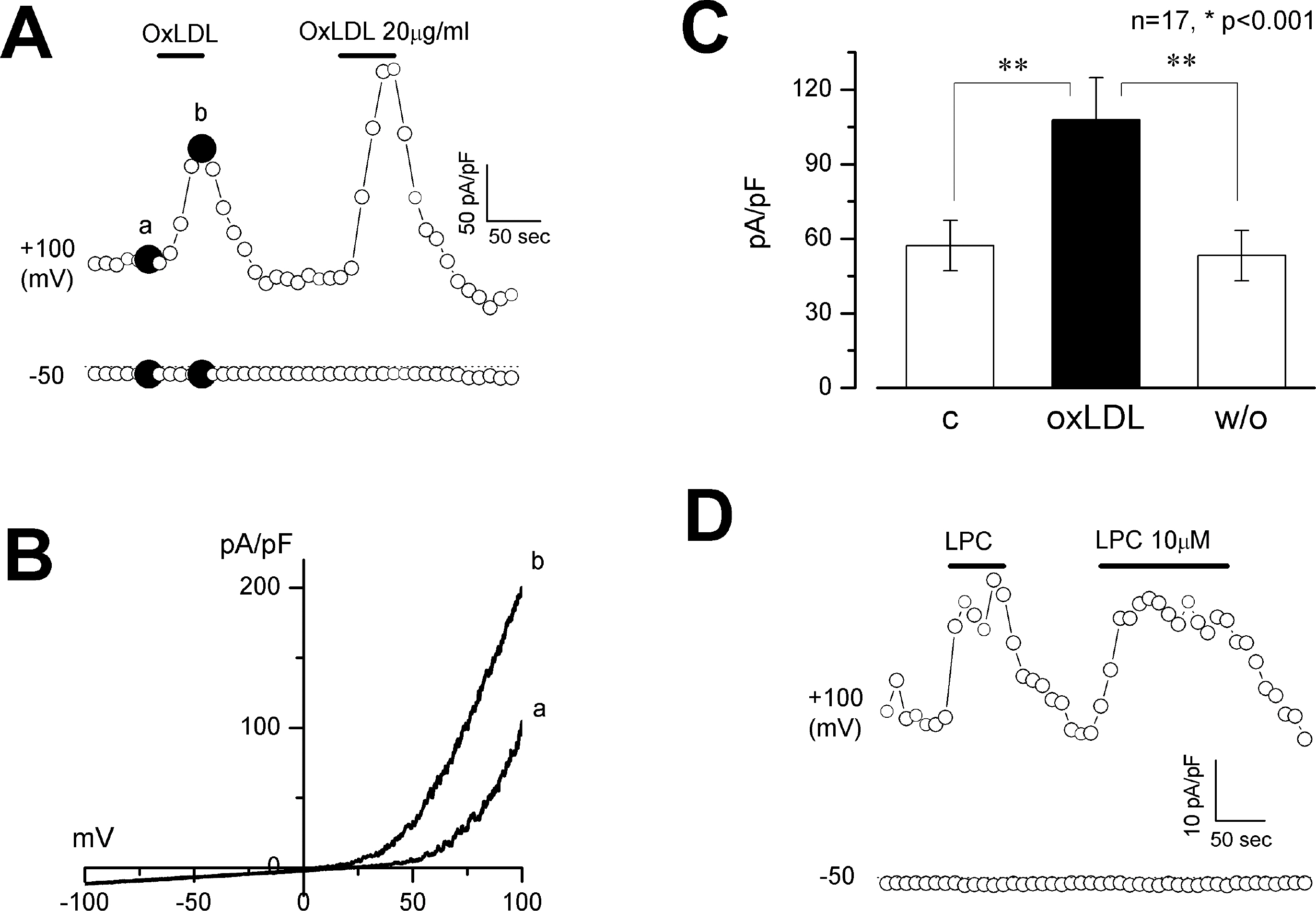Korean J Physiol Pharmacol.
2009 Feb;13(1):27-32. 10.4196/kjpp.2009.13.1.27.
Oxidized Low-density Lipoprotein- and Lysophosphatidylcholine-induced Ca2+ Mobilization in Human Endothelial Cells
- Affiliations
-
- 1Department of Physiology and Medical Research Institute, School of Medicine, Ewha Womans University, Seoul 158-710, Korea. shsuh@ewha.ac.kr
- 2Department of Thoracic and Cardiovascular Surgery, School of Medicine, Ewha Womans University, Seoul 158-710, Korea.
- KMID: 2285368
- DOI: http://doi.org/10.4196/kjpp.2009.13.1.27
Abstract
- The effects of oxidized low-density lipoprotein (OxLDL) and its major lipid constituent lysophosphatidylcholine (LPC) on Ca2+ entry were investigated in cultured human umbilical endothelial cells (HUVECs) using fura-2 fluorescence and patch-clamp methods. OxLDL or LPC increased intracellular Ca2+ concentration ([Ca2+]i), and the increase of [Ca2+]i by OxLDL or by LPC was inhibited by La3+ or heparin. LPC failed to increase [Ca2+]i in the presence of an antioxidant tempol. In addition, store-operated Ca2+ entry (SOC), which was evoked by intracellular Ca2+ store depletion in Ca2+-free solution using the sarcoplasmic reticulum Ca2+ pump blocker, 2, 5-di-t-butyl-1, 4-benzohydroquinone (BHQ), was further enhanced by OxLDL or by LPC. Increased SOC by OxLDL or by LPC was inhibited by U73122. In voltage-clamped cells, OxLDL or LPC increased [Ca2+]i and simultaneously activated non-selective cation (NSC) currents. LPC-induced NSC currents were inhibited by 2-APB, La3+ or U73122, and NSC currents were not activated by LPC in the presence of tempol. Furthermore, in voltage-clamped HUVECs, OxLDL enhanced SOC and evoked outward currents simultaneously. Clamping intracellular Ca2+ to 1 micrometer activated large-conductance Ca2+-activated K+ (BKCa) current spontaneously, and this activated BKCa current was further enhanced by OxLDL or by LPC. From these results, we concluded that OxLDL or its main component LPC activates Ca2+-permeable Ca2+-activated NSC current and BKCa current simultaneously, thereby increasing SOC.
Keyword
MeSH Terms
Figure
Reference
-
Berliner JA., Heinecke JW. The role of oxidized lipoproteins in atherogenesis. Free Radic Biol Med. 20:707–727. 1996.
ArticleFearon IM. OxLDL enhances L-type Ca2+ currents via lysophosphatidylcholine-induced mitochondrial reactive oxygen species (ROS) production. Cardiovasc Res. 69:855–864. 2006.Hessler JR., Morel DW., Lewis LJ., Chisolm GM. Lipoprotein oxidation and lipoprotein-induced cytotoxicity. Arteriosclerosis. 3:215–222. 1983.
ArticleItagaki K., Hauser CJ. Sphingosine 1-phosphate, a diffusible Ca2+ influx factor mediating store-operated Ca2+ entry. J Biol Chem. 278:27540–27547. 2003.Jabr RI., Yamazaki J., Hume JR. Lysophosphatidylcholine triggers intracellular Ca2+ release and activation of non-selective cation channels in renal arterial smooth muscle cells. Pflugers Arch. 439:495–500. 2000.Kamouchi M., Droogmans G., Nilius B. Membrane potential as a modulator of the free intracellular Ca2+ concentration in agonist-activated endothelial cells. Gen Physiol Biophys. 18:199–208. 1999.Kamouchi M., Mamin A., Droogmans G., Nilius B. Nonselective cation channels in endothelial cells derived from human umbilical vein. J Membr Biol. 169:29–38. 1999.
ArticleKim MY., Liang GH., Kim JA., Kim YJ., Oh S., Suh SH. Sphingosine-1-phosphate activates BKCa channels independently of G protein-coupled receptor in human endothelial cells. Am J Physiol Cell Physiol. 290:C1000–1008. 2006.Kuhlmann CR., Schafer M., Li F., Sawamura T., Tillmanns H., Waldecker B., Wiecha J. Modulation of endothelial Ca2+ -activated K+ channels by oxidized LDL and its contribution to endothelial proliferation. Cardiovasc Res. 60:626–634. 2003.Matsubara M., Hasegawa K. Benidipine, a dihydropyridine-Ca2+ channel blocker, prevents lysophosphatidylcholine-induced injury and reactive oxygen species production in human aortic endothelial cells. Atherosclerosis. 178:57–66. 2005.Mehta JL. The role of LOX-1, a novel lectin-like receptor for oxidized low density lipoprotein, in atherosclerosis. Canadian J Cardiol. 20(Suppl B):32B–36B. 2004.Mehta JL., Chen J., Hermonat PL., Romeo F., Novelli G. Lectin-like, oxidized low-density lipoprotein receptor-1 (LOX-1): a critical player in the development of atherosclerosis and related disorders. Cardiovasc Res. 69:36–45. 2006.
ArticleMuller J., Petkovic M., Schiller J., Arnold K., Reichl S., Arnhold J. Effects of lysophospholipids on the generation of reactive oxygen species by fMLP- and PMA-stimulated human neutrophils. Luminescence. 17:141–149. 2002.
ArticleNilius B. Permeation properties of a non-selective cation channel in human vascular endothelial cells. Pflugers Arch. 416:609–611. 1990.
ArticleNilius B., Oike M., Zahradnik I., Droogmans G. Activation of a Cl− current by hypotonic volume increase in human endothelial cells. J Gen Physiol. 103:787–805. 1994.Nilius B., Schwarz G., Oike M., Droogmans G. Histamine- activated, non-selective cation currents and Ca2+ transients in endothelial cells from human umbilical vein. Pfluers Archiv. 424:285–293. 1993.Ross R. The pathogenesis of atherosclerosis: a perspective for the 1990s. Nature. 362:801–809. 1993.
ArticleSteinberg D. Low density lipoprotein oxidation and its pathobiological significance. J Biol Chem. 272:20963–20966. 1997.
ArticleSteinberg D., Parthasarathy S., Carew TE., Khoo JC., Witztum JL. Beyond cholesterol. Modifications of low-density lipoprotein that increase its atherogenicity. N Engl J Med. 320:915–924. 1989.Steinbrecher UP., Zhang HF., Lougheed M. Role of oxidatively modified LDL in atherosclerosis. Free Radic Biol Med. 9:155–168. 1990.
ArticleSuh SH., Watanabe H., Droogmans G., Nilius B. ATP and nitric oxide modulate a Ca2+-activated non-selective cation current in macrovascular endothelial cells. Pflugers Arch. 444:438–445. 2002.Takeshita S., Inoue N., Gao D., Rikitake Y., Kawashima S., Tawa R., Sakurai H., Yokoyama M. Lysophosphatidylcholine enhances superoxide anions production via endothelial NADH/NADPH oxidase. J Atheroscler Thromb. 7:238–246. 2000.
ArticleTerasawa K., Nakajima T., Iida H., Iwasawa K., Oonuma H., Jo T., Morita T., Nakamura F., Fujimori Y., Toyo-oka T., Nagai R. Nonselective cation currents regulate membrane potential of rabbit coronary arterial cell: modulation by lysophosphatidy-lcholine. Circulation. 106:3111–3119. 2002.Thorin E., Hamilton C., Dominiczak AF., Dominiczak MH., Reid JL. Oxidized-LDL induced changes in membrane physico- chemical properties and [Ca2+]i of bovine aortic endothelial cells. Influence of vitamin E. Atherosclerosis. 114:185–195. 1995.van Tits LJ., Hak-Lemmers HL., Demacker PN., Stalenhoef AF., Willems PH. Oxidized low-density lipoprotein induces Ca2+ influx in polymorphonuclear leukocytes. Free Radic Biol Med. 29:747–755. 2000.Voets T., Wei L., De Smet P., van Driessche W., Eggermont J., Droogmans G., Nilius B. Downregulation of volume-activated Cl− currents during muscle differentiation. Am J Physiol. 272:C667–674. 1997.Weisser B., Locher R., Mengden T., Vetter W. Oxidation of low density lipoprotein enhances its potential to increase intracellular free calcium concentration in vascular smooth muscle cells. Arterioscler Thromb. 12:231–236. 1992.
ArticleYoung IS., McEneny J. Lipoprotein oxidation and atherosclerosis. Biochem Soc Trans. 29:358–362. 2001.
ArticleZhao B., Ehringer WD., Dierichs R., Miller FN. Oxidized low-density lipoprotein increases endothelial intracellular calcium and alters cytoskeletal f-actin distribution. Eur J Clin Invest. 27:48–54. 1997.
ArticleZmijewski JW., Landar A., Watanabe N., Dickinson DA., Noguchi N., Darley-Usmar VM. Cell signalling by oxidized lipids and the role of reactive oxygen species in the endothelium. Biocheml Soc Trans. 33:1385–1389. 2005.
Article
- Full Text Links
- Actions
-
Cited
- CITED
-
- Close
- Share
- Similar articles
-
- Increase of Intracellular Ca2+ Concentration Induced by Lysophosphatidylcholine in Murine Aortic Endothelial Cells
- Lysophosphatidylcholine Attenuates Endothelium-dependent Relaxation Responses through Inhibition of ACh-induced Endothelial [Ca2+]i Increase
- Fluorescent low density lipoprotein and acetylated low density lipoprotein labeling of cultured bovine trabecular endothelial cells
- Production and characterization of monoclonal antibodies to oxidized LDL
- Effects of C18 Fatty Acids on Intracellular Ca2+ Mobilization and Histamine Release in RBL-2H3 Cells






